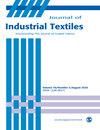Composite waste-based aramid aerogel separators
IF 2
4区 工程技术
Q1 MATERIALS SCIENCE, TEXTILES
引用次数: 0
Abstract
Lithium ion batteries are one of the most promising electrochemical energy storage systems. They generally consist of four components: anode, cathode, electrolyte, and separator. The separators are crucial for batteries since they prevent physical contact of electrodes and thus short circuit. In this study, reutilization of aramid fabric was highlighted by transforming it into a high value product: battery separator. A waste aramid fabric was used to synthesize aramid aerogels by deprotonation, sol-gel, and freeze-drying processes and then investigated as lithium ion battery separators. Aramid fabric was collected from a scrap plant of an industrial automotive company. Nanoclay or TiO基于废弃物的复合芳纶气凝胶分离器
锂离子电池是最有前途的电化学储能系统之一。它们通常由四个部分组成:阳极、阴极、电解质和隔膜。隔膜对电池至关重要,因为它能防止电极物理接触,从而防止短路。本研究通过将芳纶织物转化为高价值产品:电池隔膜,强调了芳纶织物的再利用。研究人员利用废弃芳纶织物,通过去质子化、溶胶-凝胶和冷冻干燥工艺合成了芳纶气凝胶,然后将其作为锂离子电池隔膜进行了研究。芳纶织物是从一家工业汽车公司的废料厂收集的。在溶胶-凝胶阶段,将纳米粘土或二氧化钛纳米颗粒添加到这种基于废料的芳纶气凝胶基质中,以进一步提高分离器的性能。样品通过扫描电子显微镜(SEM)、线性扫描伏安法、电化学阻抗谱(EIS)和电静态充放电测试进行了表征。所有样品都呈现出均匀无珠的形态,孔隙率超过 60%。电解质吸收和离子传导测试结果表明,加入 TiO2 纳米粒子后,电解质吸收和离子传导率分别提高了 365% 和 2.2 mS/cm。使用添加了 TiO2 的纳米复合芳纶气凝胶制备的电池具有优异的循环性能,在 200 次循环中的容量约为 160 mAh/g。
本文章由计算机程序翻译,如有差异,请以英文原文为准。
求助全文
约1分钟内获得全文
求助全文
来源期刊

Journal of Industrial Textiles
MATERIALS SCIENCE, TEXTILES-
CiteScore
5.30
自引率
18.80%
发文量
165
审稿时长
2.3 months
期刊介绍:
The Journal of Industrial Textiles is the only peer reviewed journal devoted exclusively to technology, processing, methodology, modelling and applications in technical textiles, nonwovens, coated and laminated fabrics, textile composites and nanofibers.
 求助内容:
求助内容: 应助结果提醒方式:
应助结果提醒方式:


